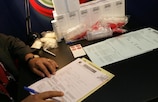Injury study gives crucial data
Monday, January 11, 2016
Article summary
The 2014/15 UEFA Elite Club Injury Study provides clubs and national associations with information and data that is invaluable in the treatment and prevention of injuries.
Article top media content

Article body
Football clubs and national associations, as well as the scientific community at large, will benefit from the information contained in UEFA's Elite Club Injury Study for 2014/15.
The report has been established on behalf of the UEFA Medical Committee by the committee's first vice-chairman Professor Jan Ekstrand, and provides crucial football-specific data that should help in the daily work of treating and preventing injuries.
Results are compiled from the period between July 2014 and May 2015 from 23 clubs that qualified for the 2014/15 UEFA Champions League group stage. Data is given on, among other things, exposure, general injury patterns, training injuries, match injuries, severe injuries, muscle injuries, ligament injuries, re-injuries, and squad attendance/availability and absences.
The report has been in operation since 2001, and represents an unparalleled historical archive of injury data specific to football. This data offers vital information for clubs, associations and the wider scientific community about injury patterns, risks, the likely prevalence of certain injury types and expected 'return to play' times.
"The UEFA injury study provides a unique scientific resource for UEFA and the football medical community, with over 13 years of historical data and trends on injuries in elite football," says Professor Ekstrand.
The study has also created a unique community of doctors, who meet once a year to discuss injury trends and to share their experiences in an open forum of a kind that is rare among rivals in elite sport.
"Thanks to the cooperation and support of clubs in UEFA's elite competitions," Dr Ekstrand adds, "more is known about injury patterns at the elite level in football than any other major international sport, and through the individual reports, teams can benchmark their performance in injury prevention and management against those of other elite clubs.
"What all this means in terms of the game itself is that elite player availability is higher, performance is better, and the health and welfare of players is protected in the best possible way."
Positive medical signs were noted in the current report in comparison with the previous season (2013/14), with the risk of injury reduced both in training and matches. In addition, the squad absence of players because of injury was lower for both training and matches compared with 2013/14.
A variety of interesting facts can be found in the study. For example, at the post-season meeting with all team doctors in July 2014, discussions included possible factors behind injuries at elite level football, and there was a consensus of four important factors: load on players; leadership styles of coaches/managers; internal communication; and well-being of players.
"One could speculate whether consideration of these factors might have been a reason for the lowering of injuries during the 2014/15 season," Professor Ekstrand reflects.
Another consideration within the report is that while the 're-injury' rate – that is, an identical injury occurring within two months of the medical team giving the green light for a player's full participation in training and matches after the initial injury – was, on average, 8%, which is similar to the previous season. However, the study finds that the variation between teams is huge – between 0 and 31%.
"This is certainly an area where some clubs could learn from others," says Professor Ekstrand. "Is it better to be safe [in allowing a player to resume training and matches] than quick?"



